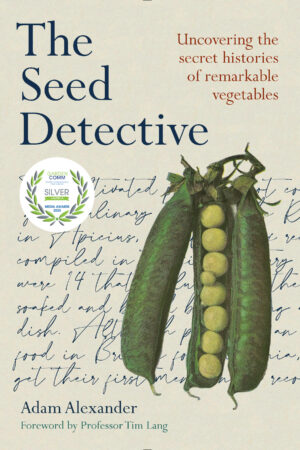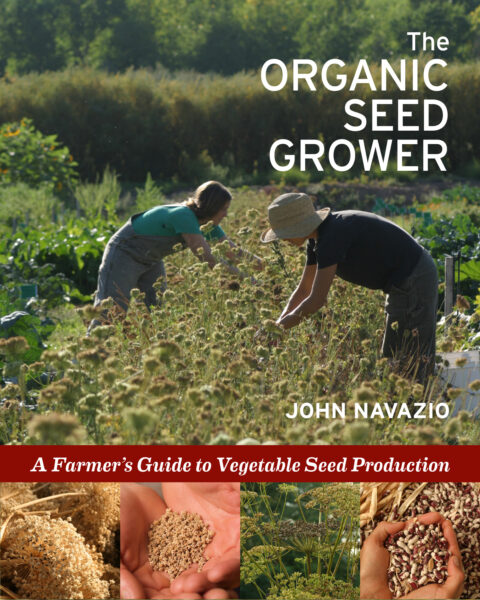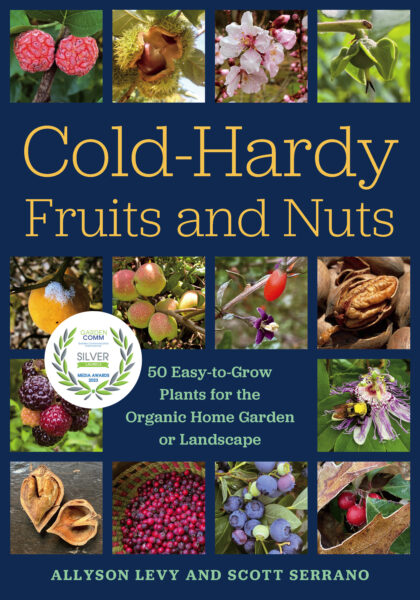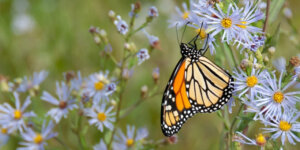The Search for A Welsh Leek
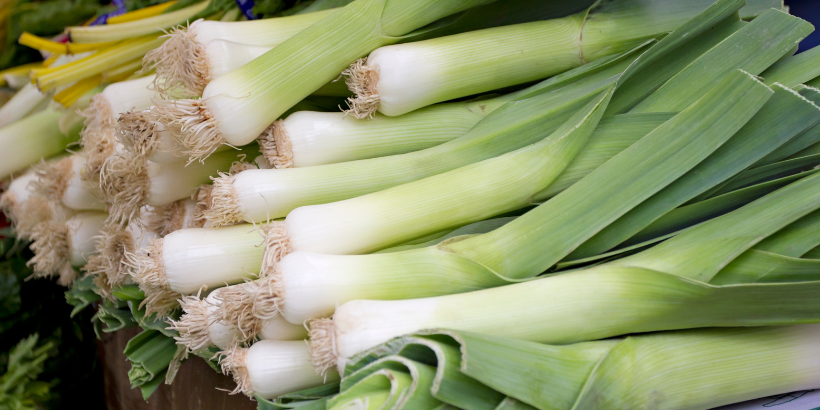
How did the modern leek become what it is today? On his quest to save our heritage produce, Adam Alexander (otherwise known as the Indiana Jones of vegetables) unveiled the complex history behind leeks and many other veggies, along with how they made our way to our dinner plates.
While on this mission, Adam started to search for a true Welsh heritage or heirloom leek. But did he ever find one? In the excerpt below, he discusses his journey and what he’s learned about leeks along the way.
The following is an excerpt from The Seed Detective by Adam Alexander. It has been adapted for the web.
‘Eat leeks in March and wild garlic in May, and all the year after the physicians may play.’ — Traditional Welsh rhyme
There is something incredibly British about growing leeks and it is at our county shows or vegetable society bashes that we see how huge these things can become. Just don’t ever ask me to eat one. These leeks are different to those which the average gardener grows, not just because of their great length and girth, but also because they are not usually grown from seed. Instead, they are cultivated from offsets which are clones of the parent. Grown in this way, competition leeks are all genetically identical to each other and it is the skills of the grower that determine its perfection and not its personality on the plate, as flavour is not judged.
When it comes to enjoying the finest of culinary leeks, it is to the seed packet one turns. This hardy member of the same family as onions, shallots and garlic has been domesticated from the wild leek, Allium ampeloprasum. This name is derived from two words: prason is the Greek word for ‘leek’ and ampelo means ‘vine’. The Latin name for the wild species means ‘the allium that grows in the vineyard’. It was the Roman physician Dioscorides (c.40–c.90 ce), who noticed that vineyards were much favoured by the plant.
A Plant of Many Talents
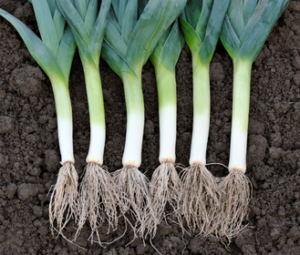 The wild leek probably arrived in Britain in prehistoric times.1 It grows mainly in parts of South West England and South Wales, on rocky coastlines and damp places that have undergone human disturbance, such as the building of drainage ditches. There is a story that the wild leek was brought to the island of Flat Holm, a small blob in the Bristol Channel, by Augustine monks in the twelfth century. However, it is more likely, as we shall see, that the monks brought with them the seed of a cultivated leek which would then have crossed freely with any wild leeks on the island.
The wild leek probably arrived in Britain in prehistoric times.1 It grows mainly in parts of South West England and South Wales, on rocky coastlines and damp places that have undergone human disturbance, such as the building of drainage ditches. There is a story that the wild leek was brought to the island of Flat Holm, a small blob in the Bristol Channel, by Augustine monks in the twelfth century. However, it is more likely, as we shall see, that the monks brought with them the seed of a cultivated leek which would then have crossed freely with any wild leeks on the island.
Wild leeks are also found in the northwest corner of Wales, at South Slack on the island of Anglesey, where they had a particularly good year in 2013 when the pretty flower spikes reached 2.5m (8ft) in length. The wild leek would have been used primarily as a tonic in ancient times – it may be less effective for its medicinal qualities than its relative, garlic, although some herbalists dispute this. Nonetheless, wild leeks, which could apparently deter moles, were an important cure for the common cold and as a tonic to restore the iron lost after menstruation. Leeks were also considered a useful aid for childbirth and for avoiding being struck by lightning. They were used as a moth and insect repellent too, but I imagine smearing leek juice all over oneself to keep bugs at bay might have proved a human repellent as well. Today, a cursory trawl of the internet reveals plenty of other claims for this vegetable. It is said to be good for the heart, to lower blood pressure, to have powerful anti-cancer properties, be good for brain function, and reduce the chance of having a stroke. How can we argue against eating leeks when they are obviously so good for us? The leek is also not alone among foods that have a phallic appearance, having been associated with love and lechery – a great vegetable to pep up one’s love life.2
Emblem of National Identity
The leek is one of two great Welsh cultural icons: the other being the daffodil whose Welsh name, Cennin Pedr, means ‘Peter’s Leek’. The leek received a special place in Welsh culture and British literature at the Battle of Crécy in 1346.* Colourfully described by the Bard himself in his play Henry V, written 250 years after the battle, the comical soldier Fluellin tells the king about Welsh soldiers wearing leeks in their Monmouth caps. Early in the twentieth century there was much ill-tempered hot air, mudslinging and verbiage written by some patriotic Welsh botanists and local historians about which plant was the true emblem for Wales. Efforts to discredit earlier references in favour of the leek, including from Shakespeare, were legion. Needless to say, the daffodil mob poured scorn on all historical texts that cast doubt on their claim. And any reference to the Battle of Crécy was ‘of no trustworthy authority’. In 1911, the British Prime minister David Lloyd George, who was a committed advocate for the daffodil, made sure that it was used as the official symbol during the investiture of the new Prince of Wales at Caernarfon Castle. The leek was nowhere to be seen; well and truly toppled from its emblematic pedestal. The battle for the leek may have been lost but the war was not over.
A sense of national outrage persisted with fabulous accusations hurled indiscriminately by the proudest Welshmen at the despised English. A certain Mr Llewelyn Williams wrote, at the height of the controversy in the first decade of the twentieth century, suggesting that the mistake of substituting a ‘stinking vegetable’ for a ‘charming flower’ was ‘due to a blunder made by Shakespeare or some other equally ignorant Saxon’ who confused the Welsh cennin, meaning ‘leek’, with Cennin Pedr.
In Search of a Welsh Leek
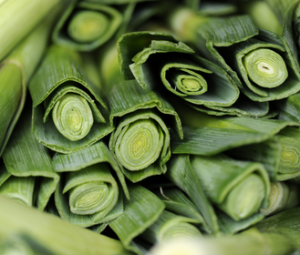 Whether or not there is a true Welsh heritage or heirloom leek – something I have yet to find – or that the nation actually enjoys eating them, is merely a sideshow to the great cultural significance of the leek. Its appearance on St David’s Day, on 1 March, celebrates a much earlier battle – that fought by King Cadwallon of Gwynedd sometime in the seventh century when his soldiers allegedly wore leeks in their helmets as identifiers. The legend tells how the plucky Welsh soldiers fought off the hated Saxon invaders, having helped themselves to the leeks growing in a nearby field. St David himself was said to have lived on a diet of bread and leeks, which ensured the saint had a sonorous and clear voice that enabled the multitude to hear him when he preached to the Welsh synod.
Whether or not there is a true Welsh heritage or heirloom leek – something I have yet to find – or that the nation actually enjoys eating them, is merely a sideshow to the great cultural significance of the leek. Its appearance on St David’s Day, on 1 March, celebrates a much earlier battle – that fought by King Cadwallon of Gwynedd sometime in the seventh century when his soldiers allegedly wore leeks in their helmets as identifiers. The legend tells how the plucky Welsh soldiers fought off the hated Saxon invaders, having helped themselves to the leeks growing in a nearby field. St David himself was said to have lived on a diet of bread and leeks, which ensured the saint had a sonorous and clear voice that enabled the multitude to hear him when he preached to the Welsh synod.
However, when looking at the two records of the wearing of leeks in battle, it seems that those arguing for the leek as a Welsh emblem displayed horticultural ignorance. The Battle of Crécy took place on 26 August 1346, when cultivated leeks would have been no thicker than a pencil and thus an insignificant emblem. Nonetheless, King Henry V’s troops, we are expected to believe, had the opportunity to follow in the footsteps of their Celtic forebears and stick a leek in their caps. In early March, however, when King Cadwallon was at war, leeks would have looked magnificent! For the sake of botanical clarity, one should remember that the Welsh leek of the seventh century would almost certainly have been introduced by the Romans, whose love of all alliums, including leeks, is discussed later. It is most unlikely to have been the wild type which, even back then, was only found growing in rocky and remote corners of the west coast of Wales.
In her wonderful book The Origin of Plants, Maggie Campbell-Culver reminds us that the entire native population of Britain, following the Roman occupation, would not have made a distinction between the vegetable garden and farmland used for cultivating crops. Life was a matter of survival and the entire community would be focused on finding and growing enough food just to stay alive. Only monks and a few scholars could read and write, and even they spent most of their time growing and foraging. Unlike today’s common expression of a kitchen garden as being ‘the cabbage patch’, at the time St David was battling the Saxon invaders the description of a place where vegetables were grown was the Leac-garth (herb garden), Leac meaning ‘herb’ in Anglo-Saxon. There would seem little doubt, therefore, that leeks were an important part of Anglo-Saxon food culture. Our obsession with this allium continues to this day, as is evident from its importance on the show-bench. Perhaps the literal translation of the location of the battle led by King Cadwallon – an unidentified field of leeks somewhere in South Wales – says more about the vegetable’s place in Welsh culture than what actual species the Welsh and their hated Saxon enemies could have been trampling over when they helped themselves from some impoverished peasant’s vegetable patch. In any event, the leeks those brave soldiers fighting for Henry V wore would have been a French variety, the result of a thousand years of cultivation after the fall of Rome and a distant relation of the common leek we enjoy today.
No Wild Side
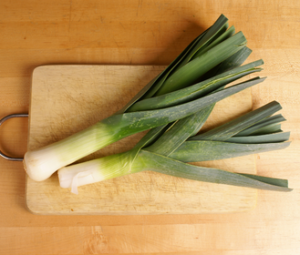 Unlike many of the vegetable characters I write about, although domesticated from the wild leek, the cultivated leek is known botanically as a cultigen – a term used to describe a cultivated plant lacking wild counterparts. This is because domestication and selective breeding over many thousands of years has given the world a species that is now quite distinct from its wild ancestors.
Unlike many of the vegetable characters I write about, although domesticated from the wild leek, the cultivated leek is known botanically as a cultigen – a term used to describe a cultivated plant lacking wild counterparts. This is because domestication and selective breeding over many thousands of years has given the world a species that is now quite distinct from its wild ancestors.
Records indicate that the cultivated or common leek was domesticated in Egypt and Mesopotamia at least 4,500 years ago. However, as the wild leek is native to all the countries bordering the Mediterranean and the Black Sea, as well as the western and northern parts of the Fertile Crescent, it would most likely have been foraged by our ancestors long after it was domesticated. It is considered naturalised in northern Europe, including parts of the U.K., throughout Indo-China and, as a result of European colonisation in the last 600 years, much of Australia and parts of the North and South American continents.
The long process of domestication has given us a number of distinct forms which have embedded themselves in several different food cultures. Wild leeks are onion-like in appearance, with small bulbs or clusters of bulbs at their base. Domesticated leeks are divided into five distinct groups, from which several different types were perfected: the Com- mon Leek, the Greater-headed Garlic, the Pearl Onion, the Kurrat, and the Taree or Persian Leek.
It is the changes in the concentric, unsheathing leaf base that were selected by farmers to create long, edible pseudo-stems. These are false stems formed from the swollen leaf base which we associate with the distinctive appearance of the common leek.4 Elephant garlic is a member of the Greater-headed Garlic group and those of us who have grown and eaten it will attest to it looking more like a giant garlic bulb than a type of leek. Only when eaten does its leek-like flavour come through, and those expecting the pungency of real garlic will be disappointed. Ditto a close Chinese relative, the Pearl Onion, which is known as a button baby onion in the U.K. and a creamer in the USA. Frequently sold as a pickled onion, it is, in fact, a type of pickled leek! The other two, the Kurrat and the Taree, look similar to the common leek. The former is the result of selection from forms of wild garlic, with an emphasis on the leaves, and remains popular in Egypt today. It’s very much a ‘cut-and-come-again’ crop, harvested every few weeks until the plant is exhausted – which can take over a year. The Taree is very similar to the Kurrat, but with narrower leaves, and is a popular ingredient in the cuisine of northern Iran. Seed from the Greater-headed Garlic group is infertile, but the other four groups are interfertile and will readily cross with each other, producing hybrids of variable culinary worth.
There are other alliums called wild leeks, which are an entirely different species. I think of the American wild leek, A. tricoccum, commonly known as ramps, which is foraged in the spring and sold at farmers markets. It is rather yummy and, confusingly, looks like the unrelated wild garlic A. ursinum which I forage near my home. Also known as ramsons, wild garlic is a wonderful, sweet-smelling sight in springtime when great drifts can be seen in British woodland glades and along rural roadside verges.
Food Stories
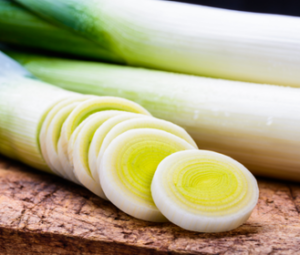 Thousands of years before the Welsh started to squabble over the cultural significance and merit of the humble leek, it had cemented a place in the earliest recipes of the eastern Mediterranean. The stories of the leek’s journey onto our plates are closely entwined with those of its two cousins, garlic and onion. They are referenced on Sumerian Cuneiform tablets, nearly 4,500 years old, along with other culinary essentials. Tablets from Mesopotamia, dating back to between 1600 and 1700 bce, and known as the Yale Babylonian Tablets, probably represent the oldest cookery book in the world and include around 40 recipes in which the Allium genus figures large. On the tablets, the leek – most probably the Taree – is called karsu. It would appear that the civilisations of Mesopotamia liked to cook leeks and garlic together purely for nourishment, as there is no record of them having any medicinal or magical properties. In the Old Testament there is a description of foodie pleasures lost to the Israelites who, while wandering the desert with Moses, thought of the good things they had left behind: ‘…We remember the fish which we did eat in Egypt, the cucumbers, melons, leeks, onions and garlic…’ (Numbers 11:4–6).
Thousands of years before the Welsh started to squabble over the cultural significance and merit of the humble leek, it had cemented a place in the earliest recipes of the eastern Mediterranean. The stories of the leek’s journey onto our plates are closely entwined with those of its two cousins, garlic and onion. They are referenced on Sumerian Cuneiform tablets, nearly 4,500 years old, along with other culinary essentials. Tablets from Mesopotamia, dating back to between 1600 and 1700 bce, and known as the Yale Babylonian Tablets, probably represent the oldest cookery book in the world and include around 40 recipes in which the Allium genus figures large. On the tablets, the leek – most probably the Taree – is called karsu. It would appear that the civilisations of Mesopotamia liked to cook leeks and garlic together purely for nourishment, as there is no record of them having any medicinal or magical properties. In the Old Testament there is a description of foodie pleasures lost to the Israelites who, while wandering the desert with Moses, thought of the good things they had left behind: ‘…We remember the fish which we did eat in Egypt, the cucumbers, melons, leeks, onions and garlic…’ (Numbers 11:4–6).
It would appear that the Egyptians also enjoyed their leeks, which would have included the Kurrat, and even venerated them. They appear on hieroglyphics and on the head or in the hand of the god Osiris. The Roman emperor Nero (37–68 ce) may have died young, but I doubt this can be blamed on his love of leeks. Like St David, who believed eating leeks helped lubricate his larynx, Nero would regularly eat large quantities to help his singing voice. As a result, he was given the nick-name Porrophagus – ‘leek-eater’ in Latin – an insulting term from an ungrateful empire. Like so many vegetables that are at the heart of European cuisine today thanks to the Romans, the domesticated leek was grown across their empire.
Anglo-Saxon Europe embraced the cultivated leek. Nutritious and a reliable, hardy crop, it could be harvested from late autumn to late spring and would have been part of a daily diet, which is why it has such an important place in our folklore and literature. Eating leeks also had negative connotations. A century or more ago, derogatory comments about people being ‘as green as a leek’, or something being ‘not worth a leek’, were a regular part of English vernacular.5 As well as praising the Welsh in the Battle of Crécy, in one scene in Henry V, Shakespeare has the Welsh character Fluellen force his English compatriot Pistol to eat a leek because ‘If you can mock a leek you can eat a leek.’
On a more positive note, it is not just the Welsh but also the Romanians who have the leek as a bedrock of their cultural identity; the Scots do, too. One just has to think of Cock-a-Leekie soup, a meal in itself, with many regional variations that all include leeks. The other quintessential Scottish dish is porridge, the name being a combination of the word ‘pottage’ and the French word porée. The Latin word for leek, porrum, became poireau in French and Porree or Lauch in German. Porrum was first used to describe a thick, leek-based vegetable soup like Cock-a-Leekie, which became extended to describe any glutinous and soupy dish made using dried peas or oatmeal.6
A Never-Ending Search
I have been on a quest to find a genuine leek that was first bred in Wales – the John and Jane Doe of the vegetable world: missing, but hopefully not deceased. This has only got me as far as the 1939 Carter’s Blue Book of Gardening seed catalogue where five varieties of leek are listed. In very small print at the bottom of the page is evidence that it did once exist: ‘The Welsh Leek…A fine improved variety of the old WELSH’ [their capitals] for the princely sum of 10d [4 new pence] an ounce [25g]’. Sadly, no longer available to buy anywhere.
This, the most recent reference I have been able to find of a commercial Welsh leek, is proof enough that they were commonly available before World War II. Despite extensive research and endless enquires to leek growers across Wales there is no evidence to suggest a local heritage or heirloom leek has ever been bred. However, my search for this elusive vegetable continues. Maybe in some forgotten corner of a garden shed in deepest Wales a Carter’s seed packet still survives…
Notes
- Christopher D. Preston, David A. Pearman, and Allan R. Hall, ‘Archaeo- phytes in Britain’, Botanical Journal of the Linnean Society 145, no. 3 ( July 2004): 257–94.
- Yann Lovelock, The Vegetable Book: An Unnatural History (London, U.K.: George Allen & Unwin, 1972): 158.
- James L. Brewster, Onions and Other Vegetable Alliums (Wallingford, U.K.: CABI, 2008).
- Lovelock, The Vegetable Book, 158.
- Lovelock, The Vegetable Book, 158.
- An article giving an account of the 25th anniversary of this discovery: Fred Searle, ‘Breeders Celebrate 25th Anniversary of First Hybrid Leek’, Fresh Produce, 5 October 2018, http://www.fruitnet.com/fpj/article/176813 /breeders-celebrate-25th-anniversary-of-first-hybrid-leek.
Recommended Reads
Recent Articles
For too long, bugs have had a negative connotation associated with them. But what if we took the time to observe the benefits of insects? It’s time to rebug our gardens, lawns, and parks! The following is an excerpt from Rebugging the Planet by Vicki Hird. It has been adapted for the web. Adding Bugs:…
Read MoreAsparagus is a delicious vegetable with a layered history. How did this aspiring spear make its way from growing in the wild to appearing on our plates? The following is an excerpt from the The Seed Detective by Adam Alexander. It has been adapted for the web. “Nature gives us the key to every secret…
Read MoreChances are, you’ve seen cattails growing on the edge of your local lake or stream at least once or twice. Instead of just passing these plants, try foraging for and cooking them to create delicious seasonal dishes! The following excerpt is from The New Wildcrafted Cuisine by Pascal Baudar. It has been adapted for the…
Read MoreGarlic mustard: while known as “invasive,” this plant can be consumed in its entirety and has great nutritional value. Plus, the garlic-flavor is a perfect addition to any recipe that calls for mustard! The following are excerpts from Beyond the War on Invasive Species by Tao Orion and The Wild Wisdom of Weeds by Katrina…
Read MorePeregrine falcons, while known as predators, are essential to our environment. These stunning birds have a rich history, an interesting present, and an uncertain future. The following is an excerpt from Feather Trails by Sophie A. H. Osborn. It has been adapted for the web. Who Are Peregrine Falcons? Though relatively uncommon wherever it occurs,…
Read More

